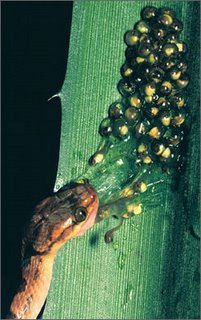
A photogenic frog found in Central America, the tree frog lives out its days high in the jungle canopy, if it survives becoming lunch for predators as a tadpole or earlier. Tree frogs hatch their eggs onto leaves overhanging ponds. Clutches of these frog embryos hatch after 6 to 8 days, falling into the ponds below. If they aren't eaten sooner. And that's where the choice comes in.
"The sensory world and behavioral decisions of embryos may be richer and more sophisticated than we imagined," reports a paper in the current Journal of Experimental Biology. The study authors, led by biologist Karen Warkentin of Boston University, report that tree frog eggs seem tuned to vibrations from predatory snakes attacking an egg clutch, leading to early hatching, up to 30% earlier than normal to escape ending up as dinner.
"In an evolutionary sense, there is a tradeoff, because early hatching leaves you more vulnerable to other predators," such as shrimp, fish and dragonfly nymphs, Warkentin says. Freshwater shrimp are a main predator of tadpoles, but only a few days of growth makes most tree frog tadpoles too big and too canny for most of the shrimp to eat. So the frogs would prefer to hatch at the latest possible date, so they are as big as possible when they hit the water. "But if you know you are about to be eaten by a snake, you might as well hatch out and take your chances," she says.
In the rain forest, the eggs are exposed to all sorts of vibrations, from rain storms mostly, Warkentin says. The eggs hatching early in response to every sort of vibration, would be a bad decision. Warkentin had previously shown the eggs hatching in response to snake attacks. But what's amazing is that experiments by Warkentin and her colleagues, Michael Caldwell and J. Gregory McDaniel show the eggs only hatch out early to the right kind of vibrations and ignore the others. The eggs have a quite narrow, specific view of what is a "scary" or "bad" vibration, and most vibrations don't scare them.
To show this, her team recorded various kinds of vibrations from rain storms to snakes biting the clutches at a jungle lab in Gamboa, Panama. They then collected almost 500 egg clutches and brought them into the lab. Each clutch contained at least 20 eggs. They connected the clutches to an experimental shaker and played various vibrations, including random white noise ones of varied length and duration.
Hatching in response to vibrations varied from effectively zero eggs to about 74% of them under the right conditions. The sweet spot was a vibration lasting just a second in duration, coming at intervals just a bit longer than a second apart. Snake attacks are also an intermittent pattern — bites and pauses. In the wild, it takes a snake minutes to eat an entire clutch, according to the study, giving the eggs time to hatch, which they mostly start doing within four seconds of an attack. "Hatching is an irreversible change for these frogs, so this is a serious choice they face," says Warkentin.
"That vibration says 'danger', it says 'scary' to the embryo," Warkentin adds. "The cool thing is that multiple lines of information have to be processed by the egg."
"Vibration-cued anti-predator defense," likely occurs widely in the animal kingdom, the study suggests. Singing frogs and crickets fall silent as people walk by after all. Some lizard eggs and fish eggs may respond similarly, but no studies have looked at vibration-cued hatching in birds yet, Warkentin says. Her team suspects that other facets of predator vibrations may cue the eggs to hatch as well, such as the actual frequency of the vibrations. Wasps also prey on tree frog eggs and the researchers hope to take a look at their vibrations as well.
Each week, USA TODAY's Dan Vergano combs scholarly journals to present the Science Snapshot, a brief summary of some of the latest findings in scientific research. For past articles, visit this index page.
http://www.usatoday.com/tech/science/columnist/vergano/2006-04-09-egg-vibration_x.htm
No comments:
Post a Comment